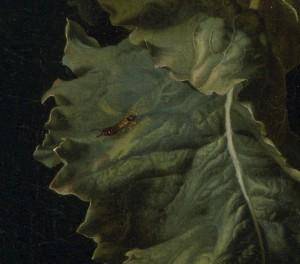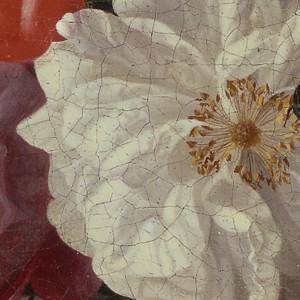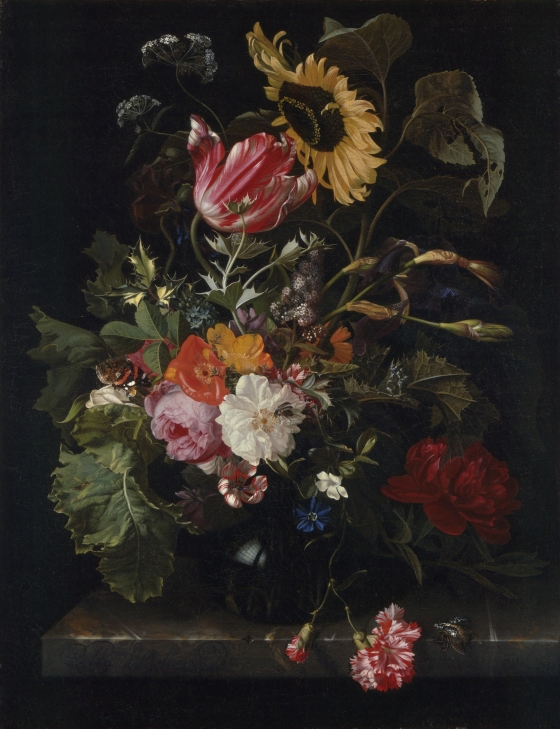Students will learn about the importance of flowers in the Netherlands during the mid-to-late 1600s. They will then explore how Oosterwyck manipulates time in her painting Bouquet of Flowers in a Vase. The lesson will culminate with students writing a poem that reflects these concepts.
Students will be able to:
- describe the economic importance of flowers in the Netherlands during the mid-to-late 1600s;
- explain how Oosterwyck used a combination of keen observation skills and her imagination to create a bouquet of flowers that bloom during different times of the year;
- identify flowers and leaves in the painting that reflect different phases of plant life; and
- use their own imagination to write a poem or draw a picture that uses the real and imaginary to reflect the phases of life.
Lesson
- Warm-up: Allow students to look at and touch the real flowers for a few minutes. Have them jot down words to describe what they feel, see, and smell. Show them Oosterwyck’s painting. What words from their examination of the flowers apply? Why do her flowers seem so real? (e.g. they evoke a sense of texture, the lighting, etc.).
- Using the About the Art section, talk about the role of flowers in the Netherlands, their value, and their role in the painting. What is valued today? Are people willing to pay a great deal for these items? Why is Oosterwyck’s painting still valued even though times have changed?
- Focus on these two main concepts in the painting: different phases of plant life and blending observation and imagination. Time has real constraints that are often harsh. Imagination can create objects (such as the flower arrangement) or ideas that are not bound by such harsh constraints. Have students identify details in the painting that reflect the different phases of plant life. You may have them work in small groups for this brainstorming.
- Share with students that research on the painting has shown that not all of those flowers would have been in bloom at the same time (and greenhouses were not a reality). How was Oosterwyck able to bring them all together in one painting, despite the real constraints of time? Help students realize the importance of blending observation and imagination in this process.
- Have students write a poem that incorporates observation and imagination and explores the phases of their life. Allow them time to share their work in small groups, critique each other’s work, and make changes as they’d like.
- Ask for volunteers to share their work with the entire class.
Materials
- An assortment of real flowers similar to those in the painting
- Lined paper and pencil/pen for each student
- Unlined paper for drawing
- Assorted colored pencils
- About the Art section on Bouquet of Flowers in a Vase
- One color copy of the painting for every four students, or the ability to project the image onto a wall or screen
Standards
- Visual Arts
- Observe and Learn to Comprehend
- Relate and Connect to Transfer
- Language Arts
- Oral Expression and Listening
- Research and Reasoning
- Writing and Composition
- Reading for All Purposes
- Collaboration
- Critical Thinking & Reasoning
- Information Literacy
- Invention
- Self-Direction
Bouquet of Flowers in a Vase
- Maria van Oosterwyck, Dutch, 1630-1693
Maria van Oosterwyck was born in Holland in 1630, the daughter of a well-to-do Protestant clergyman and his wife. She never married, though she was courted by another flower painter, Willem van Aelst. According to one source, van Aelst eventually gave up because she was so devoted to her career. Female artists were rare in the 1600s, but that didn’t keep Oosterwyck from success. Her paintings were bought by royalty, including King Louis XIV of France and King William III of England, and almost always fetched high prices.
Oosterwyck’s still-life studies included a range of objects such as glassware, coins, musical instruments, and flowers. She created complex images with lots of details, and was skilled at portraying light and reflections. She was particularly well-known for her flower paintings, and was able to capture the detail of individual flowers and foliage by sketching straight from the source. The bouquet in this painting would have been impossible to construct in real life because the flowers bloom in different seasons. Tulips, for example, bloom in the spring, while sunflowers bloom in the summer. Oosterwyck would have assembled this image of a fantasy bouquet from individual sketches she made in outdoor gardens.
During Oosterwyck’s time, the Dutch were crazy about flowers. Flowers were rare in Holland, and very expensive. Flower bulbs and seeds had to be imported from the East, and only the wealthy could afford flower gardens. As a result, flowers, especially tulips, became symbols of status.
Since only the wealthy could actually afford to buy flowers, flower paintings were a relatively “cheap” alternative and served a number of purposes. Flower paintings lasted longer than real blooms, and people enjoyed them as a reminder of spring during the cold Dutch winters. They also served as a demonstration of God’s bounty. Variety was especially valued in flower paintings—it was believed that only variety could make an image beautiful and delightful. Variety is achieved here through the portrayal of many different types of blossoms, the inclusion of foliage, the positioning of the flowers, and the inclusion of plants in different stages of growth and decay.
Details

Tulip & Sunflower
The devoutly religious Oosterwyck may have hidden a deeper meaning in our painting. In Oosterwyck’s time, flowers that turned their faces toward the sun were compared to faithful souls who followed God. Notice how the tulip bends around to face the sunflower. Huge sunflowers, with their rays of bright yellow petals, sometimes represented the sun. Some scholars have suggested that Oosterwyck was painting a faithful soul looking to God.

Decay
In the top right corner of the painting we see a leaf that has been eaten by insects. A white rose in the center of the bouquet is nearing the end of its life. Notice the small nick in the stone ledge upon which the bouquet sits. All of these things are signs of decay, and serve as reminders that all worldly things will die.

Reflection
Look closely at the vase and you will notice the reflection of a window.

Detailed Leaves
In each leaf we see individual veins, crisp edges, and the irregular coloration found in nature. During the 1600s, there was a keen interest in botany. Artists were often commissioned to illustrate botanical books and catalogues for flower sellers. Many of the people who bought flower paintings were wealthy gardeners who knew the anatomy of flowers well and wanted to see the botanical details.

Cracks
Covering the surface of the painting is a tiny network of cracks called craquelure. As paintings age, the paint or varnish will expand and contract with changes in temperature and humidity, and tiny cracks will begin to develop. Craquelure is seldom disfiguring and is simply regarded as a characteristic feature of older paintings.

Bugs
Look for butterflies, an earwig, a honeybee, and a beetle. The insects in this image are another indication of the 17th century fascination with the natural world.

Application of Paint
Oosterwyck applied the paint thinly, creating a smooth canvas. There are no ridges, lumps, or trails of paint to indicate Oosterwyck’s process. Notice how the red and white colors of the carnation do not merely exist side by side, but flow into one another gradually.
Funding for object education resources provided by a grant from the Morgridge Family Foundation. Additional funding provided by the William Randolph Hearst Endowment for Education Programs, and Xcel Energy Foundation. We thank our colleagues at the University of Denver Morgridge College of Education.
The images on this page are intended for classroom use only and may not be reproduced for other reasons without the permission of the Denver Art Museum. This object may not currently be on display at the museum.





